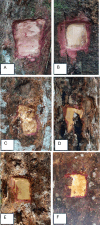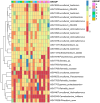Forest Type, Bark Wounding, and Tapping: Their Combined Influence on Bacteria Biota of Styrax Paralleloneurus in Natural and Community Forest
- PMID: 40908554
- PMCID: PMC12411260
- DOI: 10.1111/1758-2229.70184
Forest Type, Bark Wounding, and Tapping: Their Combined Influence on Bacteria Biota of Styrax Paralleloneurus in Natural and Community Forest
Abstract
Styrax paralleloneurus is a resin-producing tree native to Sumatra, Indonesia. This study investigated the effects of tapping, bark wounding and forest type on bacterial biota in the stem of styrax in natural and community forests. Amplicon metagenomic sequencing of the 16S rRNA region was deployed to identify the bacterial communities associated with tapped and untapped trees across various environmental and experimental conditions. The results of the study showed that tapped trees had lower abundance and diversity of Pseudomonas compared to untapped trees, largely due to their increased exposure to external microbe communities and environmental elements. Serratia and Pantoea were more abundant in natural forest than community forest, while Bradyrhizobium lablabi was found abundantly in untapped trees. Additionally, the taxonomic analysis revealed distinct responses of bacterial genera to tapping and forest type, indicating that community forests could play a significant role in promoting biodiversity in forest ecosystems. This finding underscores the importance of community forests in biodiversity conservation. These insights can inform future conservation and management strategies to enhance biodiversity and underscore the need for sustainable forest management practices to maintain forest health and productivity.
Keywords: Styrax paralleloneurus; bacteria; biodiversity; forests; next‐generation sequencing.
© 2025 The Author(s). Environmental Microbiology Reports published by John Wiley & Sons Ltd.
Conflict of interest statement
The authors declare no conflicts of interest.
Figures






References
-
- Al‐Harrasi, A. , Khan A. L., Asaf S., and Al‐Rawahi A.. 2019. “Frankincense Tree Physiology and Its Responses to Wounding Stress.” In Biology of Genus Boswellia. Springer. 10.1007/978-3-030-16725-7_4. - DOI
-
- Baker, S. C. , Spies T. A., Wardlaw T. J., Balmer J., Franklin J. F., and Jordan G. J.. 2013. “The Harvested Side of Edges: Effect of Retained Forests on the Re‐Establishment of Biodiversity in Adjacent Harvested Areas.” Forest Ecology and Management 302: 107–121.
-
- Baldrian, P. 2017. “Forest Microbiome: Diversity, Complexity and Dynamics.” FEMS Microbiology Reviews 41, no. 2: 109–130. - PubMed
MeSH terms
Substances
Grants and funding
LinkOut - more resources
Full Text Sources

